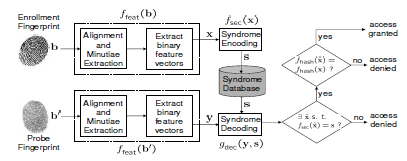TR2009-002
Securing Biometric Data
-
- , "Securing Biometric Data" in Distributed Source Coding, Dragotti, P.L. and Gastpar, M., Eds., Elsevier, January 2009.BibTeX TR2009-002 PDF
- @incollection{Vetro2009jan,
- author = {Vetro, A. and Draper, S. and Rane, S. and Yedidia, J.},
- title = {{Securing Biometric Data}},
- booktitle = {Distributed Source Coding},
- year = 2009,
- editor = {Dragotti, P.L. and Gastpar, M.},
- month = jan,
- publisher = {Elsevier},
- isbn = {978-0-12-374485-2},
- url = {https://www.merl.com/publications/TR2009-002}
- }
- , "Securing Biometric Data" in Distributed Source Coding, Dragotti, P.L. and Gastpar, M., Eds., Elsevier, January 2009.
-
MERL Contact:
-
Research Area:
Information Security

Abstract:
This chapter discusses the application of distributed source coding techniques to biometric security. A Slepian-Wolf coding system is used to provide a secure means of storing biometric data that provides robust biometric authentication for genuine users and guards against attacks from imposters. A formal quantification of the trade off between security and robustness is provided as a function of the Slepian-Wolf coding rate. Prototype secure biometric designs are presented for both iris and fingerprint modalities. These designs demonstrate that it is feasible to achieve information-theoretic security while not significantly compromising authentication performance (measured in terms of false-rejection and false-acceptance rates) when compared to conventional biometric systems. The methods described in this chapter can be applied to various architectures, including secure biometric authentication for access control and biometric-based key generation for encryption.
Related News & Events
-
NEWS Distributed Source Coding: publication by Anthony Vetro, Shantanu D. Rane and others Date: January 15, 2009
Where: Distributed Source Coding
MERL Contact: Anthony Vetro
Research Area: Information SecurityBrief- The article "Securing Biometric Data" by Vetro, A., Draper, S., Rane, S. and Yedidia, J. was published in the book Distributed Source Coding.
